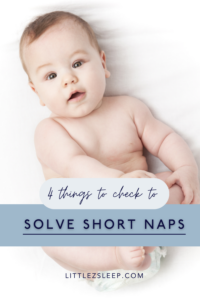4 Checks to Solve Short Naps
We’ve all been there – you put your baby to sleep for their nap and you’re happy to finally have time to hash out some work or clean up the house or maybe just take a break for an hour and a half.
But then… like clockwork, 29 minutes later or 30 minutes or even 32 minutes and 45 seconds later, they’re awake!
Today I’m going to give you the 4 checks that we’re going to use to solve your baby’s short naps. They can be so frustrating but get ready to kiss them goodbye and welcome longer naps!
Before we jump in, let’s talk about why they’re waking up around 30 minutes after they go down for a nap and then give you 4 things to look for as you work on extending those short naps.
WHY THIS IS HAPPENING
Nights & naps are different. Even the sleep cycle links are different.
At night time, usually we’re running at about 90 minutes of sleep cycles and they repeat all night long.
During the day, your baby’s sleep cycles are more like 30 minutes and this is why sometimes right on that 30 minute mark they’re waking up. It’s because one sleep cycle has ended.
Let’s go through our checklist for extending those naps!
1 – CHECK YOUR BABY’S ROOM ENVIRONMENT
There are a lot of different things we could look into here but the primary factors we’ll look at today are light and noise.
Light
I am a huge proponent of TOTAL darkness when it’s time for sleep. For babies and toddlers, they don’t know how to read a clock and so while as adults we know that it’s only been 30 minutes, so they should go back to sleep, they don’t know that. They’re awake! And what else is there to do except for wake up, call out for you, and move on with the day? Light is VERY tricky. But if anyone ever tells me that they have short naps, I will always ask – is the room super dark?
And if it’s not, then we can easily take steps to change that.
- Block sunlight from windows: Even when our eyes are closed, sunlight can still register through closed eyelids and tell our brain it’s time to wake up. If you are in your child’s darkened room and you can still see your hands in front of your face and all the objects in the room, it’s too bright. (Click here to see all my favorite products, including room darkening solutions!)
- Block light coming under the door: If your child’s room is all blacked out except for the door, a really great way to fix this is putting a fitted sheet around the door or grab a door buffer to help with efficiency with heating in there.
- Cover any sneaky blue lights: Blue lights are the WORST on the light spectrum when it comes to sleep, as opposed to red lights which are totally fine. Blue lights from things like the humidifier will cause wakings. Turn those on night mode or cover them with tape or a post-it to hide the blue light.
- No more night lights: They’re helpful when you have a newborn and you’re coming in and out of the room, but if your night lights have stayed past the newborn phase, turn those off now. They could be causing your short naps.
Noise
Within the environment, are we using white noise? White noise is my favorite because it buffers and blocks all the noise that is outside of the child’s room and protects that sleeping environment. Here’s my favorite white noise machine!
If you live in an apartment or a condo and there are shared walls, having white noise in there will help to resolve and block that out!
Or maybe there are other children in your home or you have a busy hallway right outside your child’s door – this is another opportunity to put a separate white noise machine outside their room.
Be sure to look for a continuous loop of noise that lasts throughout your child’s entire rest. We don’t want to play any music or anything that basically could run on a track and then end because once it’s over, it could wake your baby!
2 – CHECK IF YOUR CHILD’S SCHEDULE IS AGE APPROPRIATE
Sometimes we find a 7-month old on a 4-month nap schedule and I know how it gets! Time flies. But you want to be sure you’re giving your child the appropriate amount of awake time before a nap, even if they seem sleepy ahead of time.
If they need to be awake 2.5 hours and you’re only keeping them up for 2 because they’re rubbing their eyes and seem sleepy, but then they’re only sleeping for 30 minutes when they do go down, that slight adjustment may do the trick.
All the schedule changes as they grow is exactly why we’ve put together The Complete Schedule Guide. You’ll literally have every schedule you will ever need beautifully laid out, designed, and ready to print off and put all over your house so that every month you know what to do up to age 3 years old.
That first year especially, if you’re experiencing a lot of short naps, it could be because you’re not using the right schedule.
3 – CHECK FEEDING TIMES
I am the first to raise my hand here and say I am a Sleep Coach NOT a Feeding specialist! So, we definitely want you to see a lactation consultant or a feeding specialist if you have questions about all things feeding.
However, just like schedules, time flies. So while you may have been using the Eat/Play/Sleep schedule as a newborn, now with a 9-month old, Eat/Play/Sleep is not a thing anymore. It may start to feel like you’re feeding them A TON during their awake time because they’re awake for so long, but that’s normal!
You may be feeding them a bottle before and after a nap in addition to solids, too. Just be sure that they’re feeding for nourishment, not sleep.
Feeding for sleep can actually cause short naps.
4 – CHECK YOUR CHILD’S DAILY SLEEP TOTALS
Sometimes the baby is having short naps because they’re getting too much nighttime sleep.
Sounds like a great problem doesn’t it? However, if your baby is sleeping over 12 hours at night, they’re likely stealing the totals from the daytime.
For 0-16 months we’re looking for 11-12 hours of sleep at night. (For newborns up to 6 months old, they will probably have a night time feed or two!) So if your baby is getting 12-13 or even 14 hours of sleep at night, while you may be thinking this is amazing, it could be causing short naps.
And if that’s the case, do a little math rearranging here and cut off their nighttime sleep at 12 hours so that we can reallocate some of those hours for the daytime.
IN SUMMARY:
When you’re facing short naps with your baby, be sure to:
- Look at their sleep environment
- Make sure you’re on the right sleep schedule
- Ask yourself if baby’s eating at the right times and not waking up hungry
- Evaluate their total sleep needs including nights & days
LOVE THIS?? PIN FOR LATER!




